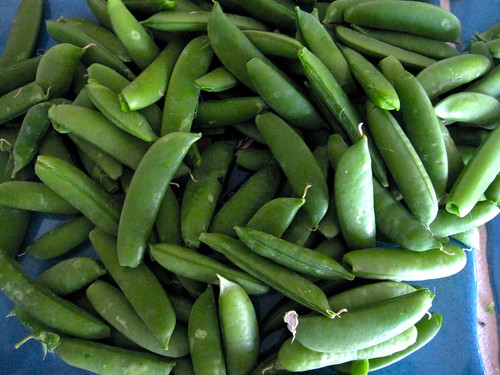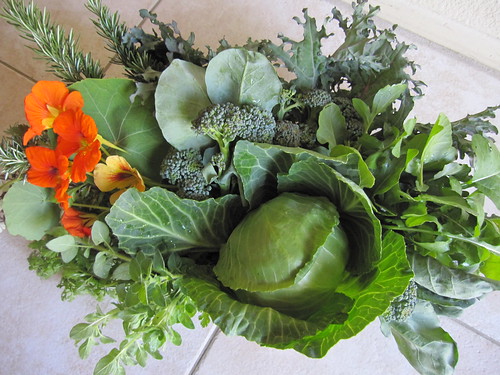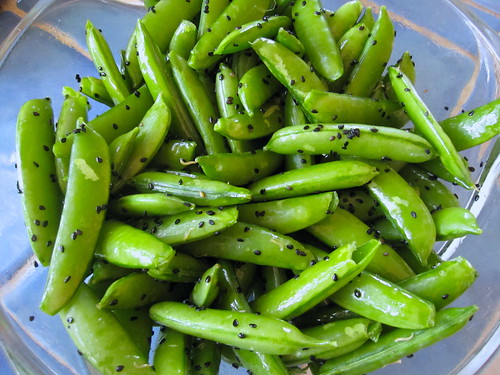Up until now, I haven’t tackled the GMO (genetically modified organism) hot button. But now that Whole Foods has announced their fabulous decision to label all GMOs, I thought it’s time. There is so much confusion on the issue and also a lot of misinformation floating around (as proved by the fact that even California couldn’t pass a law requiring GMO labeling) so it deserves to be discussed.
First a little background. Humans have been altering plants since they began growing their own food, but until now, this was done through selection, hybridizing or grafting. Selection means choosing to grow seeds of selected plants that have better qualities than others. Hybridizing means breeding two selections or varieties of the same (or sometimes even different) species with different traits to get another organism exhibiting new characteristics. Think of dog breeding. Hybridizing occurs NATURALLY but we speed up the process by deciding which two plants to “cross” by either hand pollinating, or putting the pollinators next to each other in a field.
The cross, or F1 hybrid as it is called, has traits from both parents. The offspring of distinctly different parents produce a new, uniform variety with specific characteristics from either or both parents. A great example of this is the sugar snap pea. (See below) The one thing to remember about hybridization, however, is that the seeds of the F1 hybrids cannot be used to make more F1 hybrids. Gregor Mendel demonstrated this in his famous pea experiments back in the 1800s and changed our understanding of genetics. Each year, more F1 hybrids need to be created by crossing the original parents, and that is why you need to buy seeds every year if you want to grow hybrid crops. It’s also why you can get some odd things growing in your vegetable plots if you let some of these crops go to seed. (Sorry I got a little carried away with the science, here. As a one-time geneticist, I LOVE this topic!)
Hybridization is not free from controversy. Most hybrids exhibit something called “hybrid vigor”. Many hybrid vegetables and flowers are bred to be more prolific, to grow only to a limited size or to resist specific pests or diseases which is why most home-gardeners prefer growing hybrid plants. However, some of these plants might not be as adaptable to their environment or could be more dependent on pesticides and synthetic fertilizers, and because they cross-pollinate with the better adapted wild varieties, can decrease biodiversity.
Grafting is used to provide more vigorous roots for plants such as roses, or to dwarf plants such as fruit trees, and some dwarfing root stocks may also make fruit sweeter. Heirloom tomatoes, which are very susceptible to diseases and not particularly prolific, are now being grafted onto disease-resistant roots in order to give these old varieties greater disease-resistance and a larger harvest. (I’m going to try some of these this year in my garden.) Even though grafting in nature isn’t that common, it still can happen and is therefore a “natural” process, sped up by human intervention.
GMOs, however, are modified by using highly complex technologies such as gene splicing, where genes of one organism are cut out of their DNA and pasted into another organism’s DNA, often from one kingdom to the next, such as a bacteria to a plant. (Sometimes man-made genes are inserted, as well.) This could NEVER HAPPEN NATURALLY. The DNA of Bacillus thuringiensis (Bt), for instance—a natural bacteria that kills caterpillars and some other larvae—has been spliced into the DNA of corn, potatoes and cotton so that the plants are resistant to caterpillars and worms. This may sound wonderful and inventive, but the problem is, no one knows what the long-term effects of these new organisms will be. One of the most controversial of all genetically modified products is Monsanto’s “Roundup ready” seed that has been modified so the fields of soy, corn, alfalfa, sugar beets, and canola don’t have to be weeded. Roundup ready modified seeds have been genetically engineered to resist Roundup, a powerful herbicide, so now instead of manually weeding fields, farmers saturate them with Roundup, which penetrates the plants and is consumed by the animals and people who eat them.
Many people believe that the demise of the honeybee has to do with GMO crops. One of the arguments in favor of GMOs is that it allows us to grow more food. But if the honeybees disappear, so will most of our fruits, vegetables, and nuts.
88-94% of all soy, corn, canola, alfalfa, sugar beets, papaya and cotton grown in the US are genetically modified. There have been several experiments with hamsters linking GMOs to small birth size, infertility, and shortened lifespan, and because of these experiments, many countries in Europe, Africa, and other parts of the world are either banning GMOs or restricting them. Yet in the US, we don’t even have labeling. Whether you are for or against genetic engineering in food, you, as a consumer, have a right to be told which crops are modified so you can decide whether or not you want to feed your families these altered foods. One way of ensuring your food is not GMO, even without the labeling, is to buy organic. In fact, you can pretty much assume that any processed foods that are NOT organic sold in the US have GMOs in them. You can also support stores who label GMOs.
This is a huge topic and I am just scratching the surface here. (I’m not even going into the genetic modifications that are being made to animals or cross contamination by GMO crops with non-GMO crops). To learn more you can go here and if you have more time, Google GMO. Remember…Monsanto and the processed food industry have been working very hard to keep their GMO products in the fields and on the shelves and are investing millions of dollars in pro-GMO propaganda. (That is why the California proposition failed—they spent millions on scare-tactic advertising. So did Pepsi Co, Kraft and Coca-Cola amongst others.) Go here for an incredible article by Nova/PBS where both sides of the argument are presented for you to decide. It takes a little time to go through it but this site is amazing; it will give you all the information you ever wanted or needed on the topic. Also, there are many great movies out there. One of my favorites is “The Future of Food” written and directed by Gerry Garcia’s wife, Deborah Koons Garcia. (And my niece Erica’s documentary short "The Happy Box" about subscribing to a CSA is included in the video!) If you feel passionate about this topic, you can find out how you can get involved by going to the Food Democracy Now website.
American agricultural research, the finest in the world, has created our amazing hybrids of today, but it is important that we keep a watchful eye as new technologies develop.
One of my favorite hybrid crops is the sugar snap pea, which was hybridized in the 1960’s by crossing a mutant English pea and a Chinese pea. The result, edible pods with big peas in them! You can buy them in the stores or at the farmer’s market, but they are easy to grow if you have a little space in your garden and a trellis or netting for them to cling to. I buy Super Sugar Snap by Burpee as they are disease resistant and give a huge crop. Plant as soon as you can work your soil in cold climates. In Southern California, we plant them in September or early October and are harvesting them now. We have had a lot of cool days and nights this winter, so my yield has been unbelievable.
Here is my new easy and favorite way to serve sugar snap peas. You cannot believe how delicious these are and they require NO COOKING! This recipe is a huge hit at potlucks.
***
Ina Garten’s Sugar Snap Peas
Sugar snap peas
Toasted sesame oil
Black sesame seeds
Remove strings from peas.
Put in a bowl.
Drizzle with oil until peas are coated and sprinkle with sesame seeds.
Toss and serve room temperature.
Enjoy!
Love,
WWW





0 comments:
Post a Comment